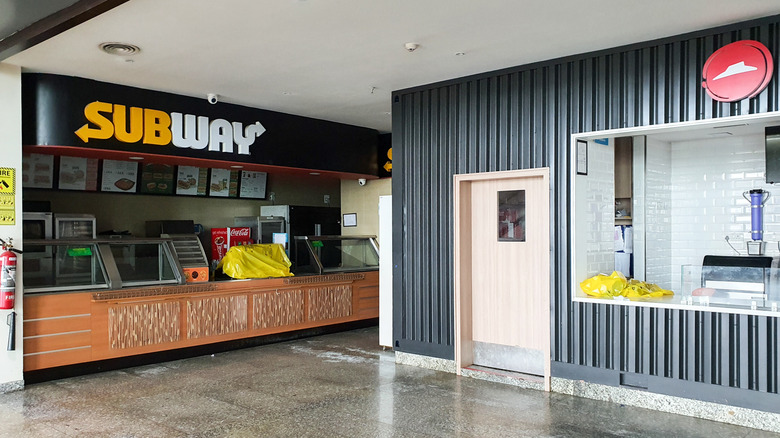The Texas High School That Boasts A Literal Food Court For Students
Allen High School in Allen, Texas, isn't your average public school; it's actually closer in scale to a small college campus. Serving nearly 7,000 students, the campus is sprawling, and it has facilities that rival those found in higher education. There's a football stadium that seats 18,000, extensive performing arts spaces, and an impressive array of academic wings. With such a massive student body, the logistics of feeding everyone efficiently are a serious consideration. That's where the food court concept comes in to save the day — the rest of us who went to normal high schools with questionable lunches just have to sit back and be haters together.
Instead of a single cafeteria line serving one or two daily options, Allen High School offers a setup more akin to an old school shopping mall food court, complete with multiple stations and branded outlets. This helps with crowd control during lunch rushes because it would be ridiculous to try to find a way to serve everyone efficiently. It also gives students variety, appealing to different tastes and dietary needs. The size of the school and the volume of meals served each day mean that having several food vendors operating side-by-side isn't as much a novelty as it is a practical solution for keeping students fed quickly without sacrificing choice or quality.
How branded chains operate inside the school
Interestingly, the school's food court features eateries that are specific to the school, including Blu, a student-run restaurant that gives students who want to pursue careers in hospitality valuable experience and exposure to the industry. There are also at least six other stations that teens can choose from, with offerings such as sandwiches, salads, soups, nachos, quesadillas, and noodles. One of the most notable features of Allen High School's dining setup is the presence of recognizable chains, such as Subway and Pizza Hut, but not in the traditional way that we're used to seeing them operate; the menus have been tweaked a bit.
When national franchises operate inside public schools, there are often modifications to meet nutritional guidelines and align with district policies. Portion sizes may be smaller, sodium content reduced, and certain menu items omitted altogether. Behind the scenes, these operations typically run under a franchise agreement — either directly with the chain or through a third-party food service provider that manages multiple brand partnerships. This means the school benefits from the name recognition and student excitement a brand brings, while still maintaining compliance with federal school meal standards. Staff who work at these branded counters are often trained to prepare menu items according to both company specifications and school regulations. You end up with a hybrid dining model that blends the familiarity of a favorite fast food brand with the oversight of a school nutrition program, giving students the best of both worlds without completely mirroring the indulgent menus found off-campus.
The broader trend and how it changes student culture
Allen High School isn't an isolated case. Many people have chimed in to say their high school follows the same or a similar format. Additionally, across Texas, more districts are rethinking what a school cafeteria can be; modernized dining spaces are becoming more common, incorporating restaurant-style seating, multiple food stations, and grab-and-go options. For students, this shift changes the culture of lunch entirely.
Instead of a mandatory trek to a drab cafeteria with limited options, lunch becomes a more social, customizable experience. Students can meet friends at a preferred vendor, try new foods, and even develop a greater appreciation for mealtime. Schools benefit, too; these upgraded facilities can help with recruitment in competitive districts and improve participation in school meal programs. It also brings in additional revenue to the school, which is something that's sort of a pain for parents, but it's still largely beneficial when you think about pouring funds into various school programs.
Some administrators view these changes as part of a larger push to prepare students for life beyond high school, where making smart dining choices and navigating food courts or quick-service restaurants can be a daily reality. The combination of efficiency, variety, and brand familiarity modernizes the dining experience and also makes lunch a highlight of the day, fostering a sense of autonomy and community that some feel the old cafeteria model rarely achieved.


